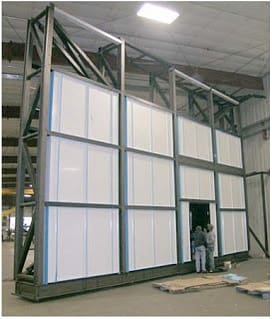We’re really proud of our engineering team. They’ve consistently designed products that raise the bar for the industry in terms of quality and performance, so much so that we’ve almost grown accustomed to their amazing design creations. Every now and then, however, they design something that makes each and every one of us take a step back and say “Wow, now THAT is impressive!”
This was the case back in 2009 when GFS Engineering tackled the issue of designing a better set of aerospace paint booth doors for use on our massive Aerospace paint booths. These aerospace paint booth doors are essentially a giant air plenum, complete with ducting and integrated filtration, that must be engineered to precise tolerances to perform above and beyond the requirements of the customer in terms of airflow, filtration, structural stability, durability, and mobility. In addition, they must be capable of withstanding some of the most intense climate conditions on the planet.
One set of such doors was installed at Elmendorf Air Force Base in Anchorage, AK. Here is the report that our engineers put together upon completion of the project:
The exterior weather door is in reality a piece of ductwork or more accurately, a swinging style plenum filter door. The exterior skin matches the architectural skin of the paint hangar in color and style and is insulated with R-12 insulation to reduce heat loss or heat gain during the year round cycle. The door is designed for operation under 60 mph sustained winds, and 100 mph winds while closed. Additionally, it will resist the Anchorage, Alaska seismic forces, a temperature differential of 125 degrees F between inside and outside, building movements and apron slopes.
The door is a nominal 4 feet thick to allow for a good air distribution to a painting area for military aircraft. The interior skin of the door is equipped with filter racks and high diffusion filters to allow a final stage of filtration before entry into the paint booth.

The plenum filter door is powered open and closed with a hydraulic ram and incorporates a separate motor for the drive machinery to permit the door leaf to be operated in a power failure by a 12V DC backup power supply. The ram is located about mid-height of the door to provide for a 10’ clear envelope around the aircraft as it is moving in and out of the booth. The combination of a cylinder at this height with a sliding hinge at the top while the door is open during a 60mph wind creates an uplift condition at the supporting wheels. The addition of 6,000 lbs of concrete to the base at the outer half of the door provides the resistance to eliminate this condition and provide for a stable design. Lightweight structural materials would not have provided any benefit.

The door assembly is equipped with a double row of seals around its entire perimeter to reduce loss of energy when in closed position. A combination of brushes and vinyl/rubber materials are used. The seals at the top are designed to accommodate the deflection of the doors during a design wind.

____________________________________
GFS is proud to say that these aerospace paint booth doors are working beautifully installed at their Alaskan home. We are also proud to say that the Aerospace Plenum Door is now a standard product offering from GFS, and we can custom-engineer virtually any size door for any size booth, from a small Cessna-size booth to a gargantuan C-17 Globemaster booth. As our engineering team has shown, the sky is the limit!
One of the best ways to highlight your business is through a story that you can share across your online platforms. It humanizes your business and shows that your business can make a meaningful impact. Your testimonial would be used as a project profile on the GFS Booth Blog and can be shared on your website and/or social media channels.
Complete this form and we’ll be in touch to showcase your company.

Shop a variety of GFS aftermarket products, including booth protection products and mobile accelerated curing units. And enjoy the convenience of fast and free ground shipping throughout the contiguous United States.

Located at GFS’ headquarters in Osseo, Wisconsin, the Center for Excellence is an innovative facility featuring an automotive refinish training center, as well as a separate space dedicated to technical product training.

GFS is continuously searching for talented, ambitious individuals to join our team. We aim to provide our employees with every opportunity to make an impact on the company and find their niche along the way — weather in a production, field services or an office position.